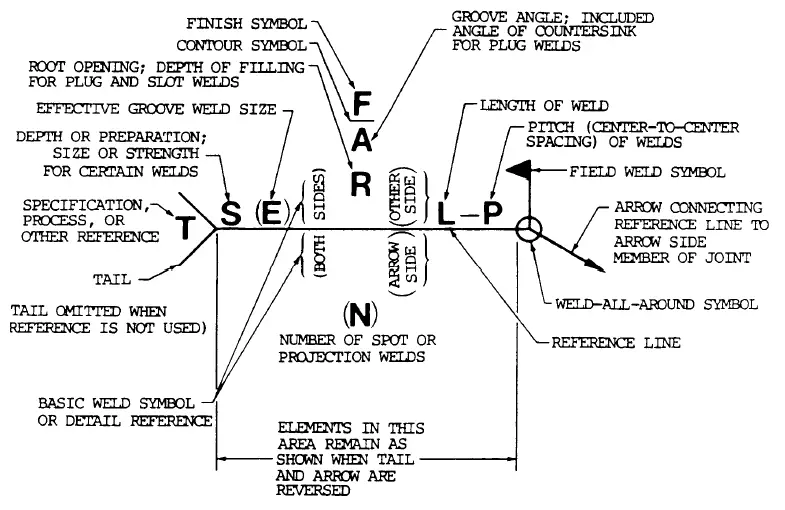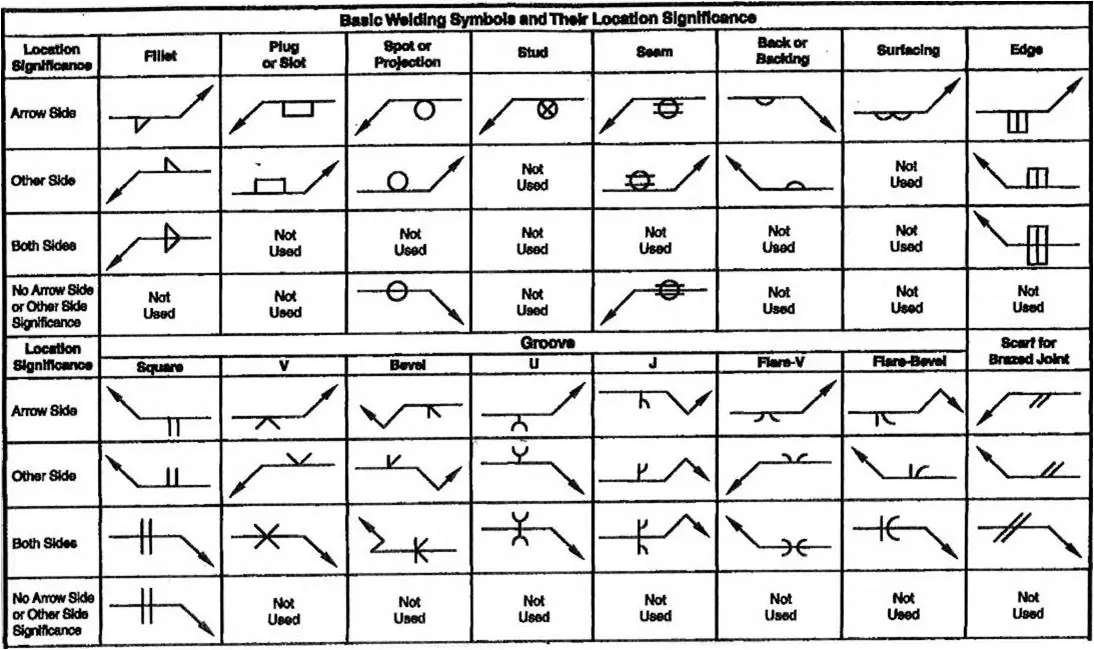Welding symbols are symbols on blueprints or shop drawings that give important welding information. For instance, welding symbols illustrate how to create a weld in a specific location and the required size, length, depth, and other information.
However, comprehending a drawing packed with welding symbols might sometimes be challenging. In light of this, let’s take a deeper look at welding symbols, their types, elements, and more!
Table of Contents
What Are Welding Symbols?
You may think of them as nothing more than modern-day hieroglyphics. Still, welding symbols are figures that give the welder important information about what they have to weld, the welding process, and other additional information.
Welding symbols are usually used by welders, engineers, architects, and foremen. In other words, these symbols serve as a means of communication between the designer and the welder.

Advantages of Welding Symbols
The most significant advantage of welding symbols is that they help execute consistent, high-quality results.
By utilizing welding symbols, a welder will know exactly where to position the welds, the correct size to make them, and the correct type of weld to apply to ensure the best possible quality.
Naturally, doing so helps prevent errors, saving time and money. For example, a welder can use a group of weld symbols instead of sketching the edge preparation for a butt/groove weld.
Even workers who operate automated welding machines benefit from having clear weld symbols marked on the design diagram.
When using these symbols as a guide, the machine operator ensures every weld joint is executed following the exact specifications provided in the blueprints.
Welding Standards
A welding standard or code is a comprehensive statement of the regulations and guidelines that must be followed while working with a certain product classification or type.
Various organizations develop welding codes. Some examples of these companies include:
- American Welding Society (AWS): The United States’ most popular welding regulations and standards creator. AWS produces several publications on the usage and quality control of welding.
- American Society of Mechanical Engineers (ASME): This association created the Boiler and Pressure Vessel Code. This standard consists of eleven parts that address the boiler and pressure vessel design, construction, and inspection.
- American Petroleum Institute (API): This organization provides a variety of documents on petroleum production, several of which involve welding standards.
Welding rules or standards have a wide range of practically endless requirements. However, I’ll focus on a few of the most common ones in these documents.
Qualifications
This section usually covers the qualification testing requirements for welding procedure specifications (WPS). It includes important factors that determine the degree of qualification.
These factors include the welding method, welding location, joint design, base metal type and thickness, and filler metal type.
The section also sets the standards for welding worker qualifications. For instance, a certified welder must be at least 18 years old and have either a high school diploma or a GED.
Manufacturing
In this section, you can find information on manufacturing techniques and craftsmanship requirements. For instance, you can find base materials specifications along with welding consumables and shielding gas quality requirements.
Lastly, the section includes information on heat treatment requirements, base material preparation and maintenance, and other welding manufacturing requirements.
Inspection
This document section usually covers the welding inspector’s qualification requirements and responsibilities.
Some of these requirements include:
- Those with an associate degree or higher must have three years of experience.
- Those with a high school diploma must have five years of experience.
- Those with an eighth-grade education must have nine years of experience.
- Those with anything less than an eighth-grade education must have 12 years of experience.
Elements of a Welding Symbol
Before delving into welding symbol elements, it’s important to understand the difference between “weld symbol” and “welding symbol.”
Simply put, the weld symbol displays the type of weld required. In contrast, the welding symbol is a means of portraying the weld symbol on blueprints.
That being said, weld symbols are made up of the two elements listed below:
Reference Line
The horizontal line, known as the reference line, acts as the foundation for all other welding symbols. Because it’s typically drawn near the weld joint, the reference line’s positioning is extremely important.
All additional symbols and information must be correctly positioned under symbol standards on or near this reference line.
Arrow
The arrow links the reference line to the welded junction. It may point in any direction, including up, down, left, and right.
It can also be positioned at either end of the reference line. Sometimes, a welding symbol can even contain multiple arrows.
You’ll often find the arrow pointing at two sides of a joint. This tells you there are two possible locations for a weld.
Types of Welding Symbols
There are two types of welding symbols: basic and supplementary. Let’s take a closer look at each one below.
Basic Welding Symbols
Basic welding symbols are the most common ones used in drawings. They’re mainly representations of different groove or butt welding types.
Some examples of basic welding symbols include:
- Single V groove welds
- Edge flanged groove welds
- Flare bevel groove welds
Basic welding symbols also include fillet welds used to create T joints, corner joints, and lap joints.

Supplementary Welding Symbols
As the name suggests, supplementary welding symbols give further information about the weld joints. The AWS and ISO standards occasionally use these symbols.
Let’s look at some examples of supplementary welding symbols.
- Flat
- Convex
- Concave
- Field weld
- Melt through
- Peripheral weld

Conclusion
Welding symbols are figures that give important information on the welding process, such as the size, location, depth, etc. By following these symbols, welders ensure that the job is completed exactly as specified in the blueprints.
Several organizations, such as AWS, ASME, and API, set welding standards. These standards include qualification, manufacturing, and inspection requirements.
Welding symbols consist of two elements: the reference line and the arrow. Lastly, there are two categories of welding symbols: basic and supplementary.

